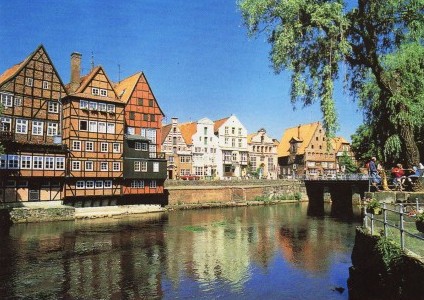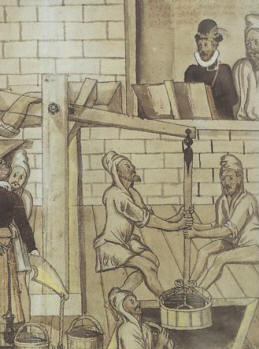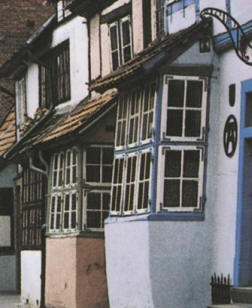
Costa del sol bjuder på många dina utflyktsmål.
Läs om mina förslag på vackra bergsturer.
Välkommen till min webbsida som handlar om trivsamma platser i Europa, utflykter i Andalusien och sköna promenader i Stockholm.
Klicka på det som intresserar dig!
Trevlig läsning

Wasserviertel with the herring square
LÜNEBURG

E22, A1, 24 km from exit 40 Garlstorf (north: exit Maschener Kreuz; south: exit 44 Soltau east from E45, A7) /23 km/
This city is overwhelming. Wherever you look you are amazed by the huge house gables which outshine each other in grandeur and fanciful ornamentations. After a stroll around the town you may think there can hardly be much more on offer, but lo and behold, yet another fantastic square, yet another parade is waiting around the corner!
What, then, is the source of all this wealth? It is salt, that indispensable article, which was discovered here over a thousand years ago. According to legend some huntsmen felled a white wild boar, but it was not an albino; this white swine had simply been wallowing in a salt puddle, and so the huntsmen came upon the white gold. True or not, there is a document from 956 where “Liuniburg” is first mentioned in connection with a salt work.
From Lüneburg the salt was transported over the ancient Roman way, “via Regia”, to Lübeck and from there it was shipped further north, supplying the Baltic states with the much-needed salt. Up in the North herring was still a staple diet and one barrelful of salt was required for the production of five barrels of herring. Small wonder, then, that places which traded in salt grew so rich and prosperous.

THE SALT LEFT ITS TRACES
There are still many signs of this salt production in Lüneburg. On the very spot where the salt works, one of the largest industries in Europe during the Middle Ages, was situated we now have Das Deutsche Salzmuseum. Here you can see for yourself how the salt was produced and have a go at boiling it. You can also come into contact with salt by visiting the Spa Park and take a walk along the old gradation works with their health-inducing salt water trickling down the walls of blackthorn hedges or go for a dip in the Adventure Baths with its variety of saltwater pools.

HISTORICAL FLASHBACKS
Enough of the salt. The building of a castle in 951 on top of the Chalk Mountain above the town contributed to its importance, as did the bridge over the river Ilmenau. But only after the destruction, in 1189, of the mighty neighbouring town Bardowick, and after joining the Hansa trade company, did Lüneburg become a free town of the realm.
It flourished between the 13th and the 17th centuries, experiencing its peak in the 16th century. It was during this era that the patrician families and rich merchants of the city built their stately mansions. They built them in red brick and the whole town seems to glow in a shimmer of red. This is contrasted only by the white window edgings and doors, painted blue or green. True, one or two houses with a slightly different character have been allowed to grace the city.
One example is the majestic Town Hall. The building of it was started as early as 1230, but now it displays an elaborate baroque façade to the Marktplatz. This market square forms the hub of the town and from here it will only take you a few minutes’ walk, along pleasant, pedestrian streets, to reach the many sights and famous landmarks.
Quite nearby you will find the Nicolaus Church, which was consecrated in 1409. East of the church is Das Alte Kaufhaus, a storehouse from 1745, also with a beautiful baroque façade, which once traded in herring with Skanör in Sweden. Here we can also see the old crane from 1332 – thoroughly restored – which was used for loading salt onto barges.
If you carry on walking south along the Ilmenau you will come to the Museum of the Principality of Lüneburg. From the museum peninsula a bridge across the river Ilmenau takes you back into the town centre. Here you will find the Johannes Church, a huge building in brick with a 108 metre high tower, quite dominating the medieval trading place “Am Sande”. This place constitutes a unique cluster of medieval brick architecture in the Gothic, Renaissance and Baroque styles. The houses all turn their decorative gables proudly towards the square, revealing the immense wealth enjoyed by the good burghers of Lüneburg in times gone by.
SALT MAKES YOU THIRSTY
But, when all is said and done, “Salz macht durstig”, salt makes you thirsty. This might explain the fact that there were some 80 breweries in the town in the 16th century! Even today the beer is flowing in the many beer halls, frequented by all the students who have come here since Lüneburg got its university, which was as late as in 1989. The natural student haunt is the Wasserviertel, The Water Quarter, at the Stint Square, but all over town there are cheerful “Biergarten” and pleasant restaurants, often housed inside old breweries or medieval cellar vaults.
Weighing of salt
Richly decorated gables everywhere
Bay windows at "Knights Street"
Salt makes you thirsty